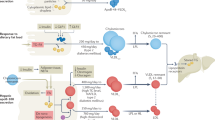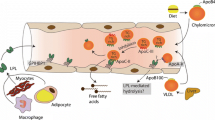Abstract
Hepatic lipase (HL) plays a role in the metabolism of chylomicron and very low-density lipoprotein remnants, lowdensity lipoproteins (LDL), and high-density lipoproteins (HDL), which are all implicated in atherosclerosis. Considering the effects of HL on these lipoproteins, it appears that HL has pro- as well as antiatherogenic potential. In line with clinical observations, most effects of HL on lipoprotein metabolism during hypertriglyceridemia may be interpreted as promoting atherosclerosis (formation of small, dense LDL, lowering of HDL levels), whereas most effects during hypercholesterolemia seem to be potentially antiatherogenic (stimulation of reverse cholesterol transport, clearing of intermediate-density lipoprotein). The potential modulation of pro- or antiatherogenics effect of HL by other factors, such as LDL receptor, cholesterol ester transfer protein, lipoprotein lipase, and ATP-binding cassette A-I activity, is discussed.
Similar content being viewed by others
References and Recommended Reading
Nong Z, Gonzalez-Navarro H, Amar M, et al.: Hepatic lipase expression in macrophages contributes to atherosclerosis in apoE-deficient and LCAT-transgenic mice. J Clin Invest 2003, 112: 367–378.
Jansen H, Verhoeven AJ, Sijbrands EJ: Hepatic lipase: a pro- or anti-atherogenic protein? J Lipid Res 2002, 43: 1352–1362.
Zambon A, Hokanson JE, Brown BG, Brunzell JD: Evidence for a new pathophysiological mechanism for coronary artery disease regression: hepatic lipase-mediated changes in LDL density. Circulation 1999, 99: 1959–1964.
Dugi KA, Feuerstein IM, Hill S, et al.: Lipoprotein lipase correlates positively and hepatic lipase inversely with calcific atherosclerosis in homozygous familial hypercholesterolemia. Arterioscler Thromb Vasc Biol 1997, 17: 354–364.
Connelly PW, Hegele RA: Hepatic lipase deficiency. Crit Rev Clin Lab Sci 1998, 35: 547–572.
Andersen RV, Wittrup HH, Tybjaerg-Hansen A, et al.: Hepatic lipase mutations, elevated high-density lipoprotein cholesterol, and increased risk of ischemic heart disease: the Copenhagen City Heart Study. J Am Coll Cardiol 2003, 41: 1972–1982.
Fan Y, Laaksonen R, Janatuinen T, et al.: Hepatic lipase gene variation is related to coronary reactivity in healthy young men. Eur J Clin Invest 2001, 31: 574–580.
Hokanson JE, Cheng S, Snell-Bergeon JK, et al.: A common promoter polymorphism in the hepatic lipase gene (LIPC-480C>T) is associated with an increase in coronary calcification in type 1 diabetes. Diabetes 2002, 51: 1208–1213.
Berg A, Frey I, Baumstark MW, et al.: Physical activity and lipoprotein lipid disorders. Sports Med 1994, 17: 6–21.
Kong C, Nimmo L, Elatrozy T, et al.: Smoking is associated with increased hepatic lipase activity, insulin resistance, dyslipidaemia and early atherosclerosis in Type 2 diabetes. Atherosclerosis 2001, 156: 373–378.
Baynes C, Henderson AD, Anyaoku V, et al.: The influence of regional adiposity on atherogenic risk factors in men and women with type 2 diabetes. Diabetes Med 1991, 8: 458–463.
Carr MC, Hokanson JE, Zambon A, et al.: The contribution of intraabdominal fat to gender differences in hepatic lipase activity and low/high density lipoprotein heterogeneity. J Clin Endocrinol Metab 2001, 86: 2831–2837.
Allayee H, Dominguez KM, Aouizerat BE, et al.: Contribution of the hepatic lipase gene to the atherogenic lipoprotein phenotype in familial combined hyperlipidemia. J Lipid Res 2000, 41: 245–252.
Zambon A, Bertocco S, Vitturi N, et al.: Relevance of hepatic lipase to the metabolism of triacylglycerol-rich lipoproteins. Biochem Soc Trans 2003, 31: 1070–1074.
Segrest JP: The role of non-LDL:non-HDL particles in atherosclerosis. Curr Diabetes Rep 2002, 2: 282–288.
Packard CJ, Shepherd J, Lindsay GM, et al.: Thyroid replacement therapy and its influence on postheparin plasma lipases and apolipoprotein-B metabolism in hypothyroidism. J Clin Endocrinol Metab 1993, 76: 1209–1216.
Havel RJ: Genetic underpinnings of LDL size and density: a role for hepatic lipase? Am J Clin Nutr 2000, 71: 1390–1391.
Austin MA, Talmud PJ, Luong LA, et al.: Candidate-gene studies of the atherogenic lipoprotein phenotype: a sib-pair linkage analysis of DZ women twins. Am J Hum Genet 1998, 62: 406–419.
Austin MA, Stephens K, Walden CE, Wijsman E: Linkage analysis of candidate genes and the small, dense low-density lipoprotein phenotype. Atherosclerosis 1999, 142: 79–87.
Jansen H, Hop W, van Tol A, et al.: Hepatic lipase and lipoprotein lipase are not major determinants of the low density lipoprotein subclass pattern in human subjects with coronary heart disease. Atherosclerosis 1994, 107: 45–54.
Kwiterovich PO Jr: Clinical relevance of the biochemical, metabolic, and genetic factors that influence low-density lipoprotein heterogeneity. Am J Cardiol 2002, 90: 30i-47i.
Diabetes Atorvastin Lipid Intervention (DALI) Study Group: The effect of aggressive versus standard lipid lowering by atorvastatin on diabetic dyslipidemia: the DALI study: a double-blind, randomized, placebo-controlled trial in patients with type 2 diabetes and diabetic dyslipidemia. Diabetes Care 2001, 24: 1335–1341.
Packard CJ, Shepherd J: Action of danazol on plasma lipids and lipoprotein metabolism. Acta Obstet Gynecol Scand Suppl 1994, 159: 35–40.
von Eckardstein A, Crook D, Elbers J, et al.: Tibolone lowers high density lipoprotein cholesterol by increasing hepatic lipase activity but does not impair cholesterol efflux. Clin Endocrinol (Oxford) 2003, 58: 49–58.
von Eckardstein A, Nofer JR, Assmann G: High density lipoproteins and arteriosclerosis. Role of cholesterol efflux and reverse cholesterol transport. Arterioscler Thromb Vasc Biol 2001, 21: 13–27.
Hill SA, McQueen MJ: Reverse cholesterol transport—a review of the process and its clinical implications. Clin Biochem 1997, 30: 517–525.
Dugi KA, Brandauer K, Schmidt N, et al.: Low hepatic lipase activity is a novel risk factor for coronary artery disease. Circulation 2001, 104: 3057–3062.
Hirano K, Yamashita S, Kuga Y, et al.: Atherosclerotic disease in marked hyperalphalipoproteinemia. Combined reduction of cholesteryl ester transfer protein and hepatic triglyceride lipase. Arterioscler Thromb Vasc Biol 1995, 15: 1849–1856.
Kimura H, Miyazaki R, Imura T, et al.: Hepatic lipase mutation may reduce vascular disease prevalence in hemodialysis patients with high CETP levels. Kidney Int 2003, 64: 1829–1837.
Vega GL, Clark LT, Tang A, et al.: Hepatic lipase activity is lower in African American men than in white American men: effects of 5′ flanking polymorphism in the hepatic lipase gene (LIPC). J Lipid Res 1998, 39: 228–232.
Zambon A, Deeb SS, Hokanson JE, et al.: Common variants in the promoter of the hepatic lipase gene are associated with lower levels of hepatic lipase activity, buoyant LDL, and higher HDL2 cholesterol. Arterioscler Thromb Vasc Biol 1998, 18: 1723–1729.
Tietge UJ, Maugeais C, Cain W, et al.: Overexpression of secretory phospholipase A(2) causes rapid catabolism and altered tissue uptake of high density lipoprotein cholesteryl ester and apolipoprotein A-I. J Biol Chem 2000, 275: 10077–10084.
Maugeais C, Tietge UJ, Broedl UC, et al.: Dose-dependent acceleration of high-density lipoprotein catabolism by endothelial lipase. Circulation 2003, 108: 2121–2126.
Rashid S, Barrett PH, Uffelman KD, et al.: Lipolytically modified triglyceride-enriched HDLs are rapidly cleared from the circulation. Arterioscler Thromb Vasc Biol 2002, 22: 483–487.
Duong M, Psaltis M, Rader DJ, et al.: Evidence that hepatic lipase and endothelial lipase have different substrate specificities for high-density lipoprotein phospholipids. Biochemistry 2003, 42: 13778–13785.
Nofer JR, Kehrel B, Fobker M, et al.: HDL and arteriosclerosis: beyond reverse cholesterol transport. Atherosclerosis 2002, 161: 1–16.
Frenais R, Nazih H, Ouguerram K, et al.: In vivo evidence for the role of lipoprotein lipase activity in the regulation of apolipoprotein AI metabolism: a kinetic study in control subjects and patients with type II diabetes mellitus. J Clin Endocrinol Metab 2001, 86: 1962–1967.
Fielding PE, Nagao K, Hakamata H, et al.: A two-step mechanism for free cholesterol and phospholipid efflux from human vascular cells to apolipoprotein A-1. Biochemistry 2000, 39: 14113–14120.
Rashid S, Watanabe T, Sakaue T, Lewis GF: Mechanisms of HDL lowering in insulin resistant, hypertriglyceridemic states: the combined effect of HDL triglyceride enrichment and elevated hepatic lipase activity. Clin Biochem 2003, 36: 421–429.
Yu KC, Cooper AD: Postprandial lipoproteins and atherosclerosis. Front Biosci 2001, 6: D332-D354.
Navab M, Hama SY, Hough GP, et al.: High density associated enzymes: their role in vascular biology. Curr Opin Lipidol 1998, 9: 449–456.
Lambert G, Chase MB, Dugi K, et al.: Hepatic lipase promotes the selective uptake of high density lipoprotein-cholesteryl esters via the scavenger receptor B1. J Lipid Res 1999, 40: 1294–1303.
Collet X, Tall AR, Serajuddin H, et al.: Remodeling of HDL by CETP in vivo and by CETP and hepatic lipase in vitro results in enhanced uptake of HDL CE by cells expressing scavenger receptor B-I. J Lipid Res 1999, 40: 1185–1193.
Author information
Authors and Affiliations
Rights and permissions
About this article
Cite this article
Jansen, H. Hepatic lipase: Friend or foe and under what circumstances?. Curr Atheroscler Rep 6, 343–347 (2004). https://doi.org/10.1007/s11883-004-0044-3
Issue Date:
DOI: https://doi.org/10.1007/s11883-004-0044-3




